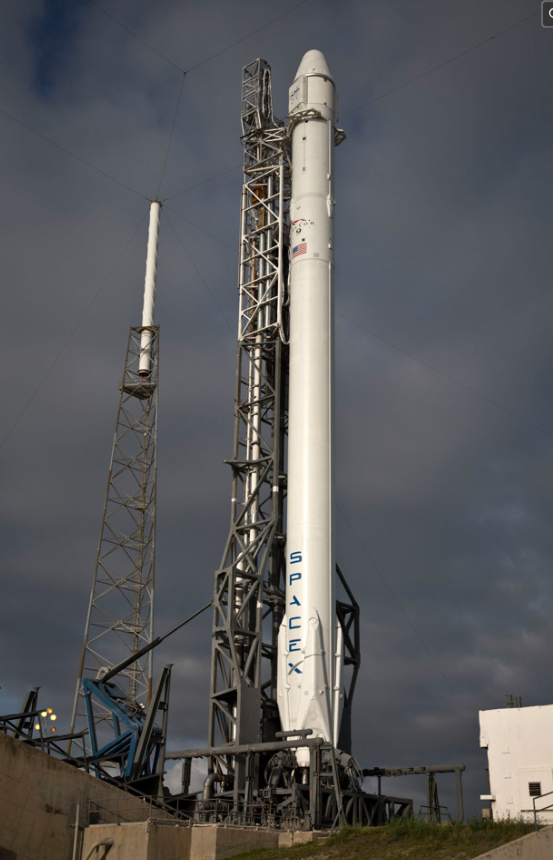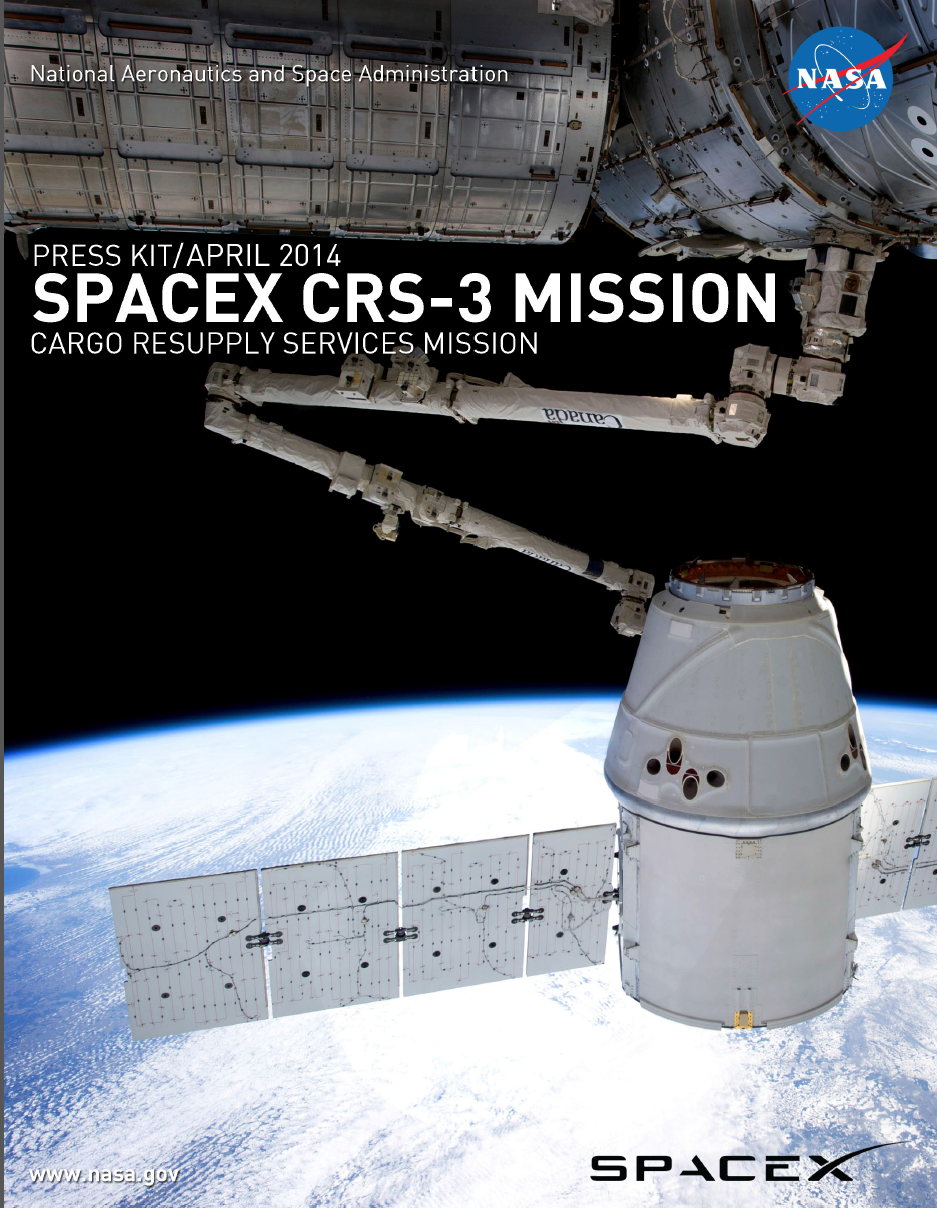[SatNews] It's a long trip to bring supplies, but they've done it successfully before...
CRS-3 Update
Today’s launch has been scrubbed due to a Helium leak on Falcon 9’s first stage. A fix will be implemented by the next launch opportunity on Friday April 18, though weather on that date isn’t ideal. Check back here for updates.
Today, SpaceX’s Falcon 9 rocket and Dragon spacecraft are set to launch the CRS-3 mission to the International Space Station (ISS) for NASA. Liftoff is targeted for 4:58pm EDT from SpaceX’s Launch Complex 40 at Cape Canaveral Air Force Station in Florida. Dragon will be loaded with nearly 5,000 pounds of supplies and science experiments bound for the ISS, and if all goes according to plan, the spacecraft will berth with the station around 7:00am EDT on Wednesday April 16th. A full mission press kit is attached.
SpaceX’s live launch webcast will begin at 4:20pm EDT at www.spacex.com/webcast.
To support more critical science payloads for the ISS, the spacecraft flying today has nearly four times its previous powered cargo capability. Dragon will carry additional freezers in its pressurized section and for the first time ever, powered cargo inside its unpressurized trunk—NASA’s OPALS and HDEV experiments. The spacecraft is also sporting redesigned cargo racks to accommodate the additional payloads.
After becoming the first private company to dock at the International Space Station 9 (ISS) in 2012 SpaceX dispatched its Dragon capsule to deliver supplies to the ISS under contract from NASA. SpaceX live streamed the launch and subsequently posted the liftoff to YouTube:
BBC reports that Dragon was carrying “400kg of food, clothing, experiments and spares” to the astronauts at the ISS. The capsule is scheduled to dock at the station on Wednesday.

Falcon 9 and Dragon have gone vertical in advance of today’s launch to the ISS! Launch @ 4:58pm ET - watch live here!
“SpaceX has signed on to fly at least 12 resupply missions to the ISS for NASA. The Dragon, which SpaceX touts as the only spacecraft capable of bringing a “significant amount of supplies” back to Earth, will be hauling back scientific materials and space station hardware on its return flight.
The station now includes the Russian-built Zarya, Zvezda, Pirs, Poisk and Rassvet modules; the U.S.-built Unity, and Harmony connection modules, the Quest airlock module, the Tranquility module and its 360-degree-view cupola, and the Permanent Multipurpose Module. Research facilities populate the U.S. Destiny Laboratory, the European Columbus Laboratory, and the Japanese Kibo laboratory and external experiment platform. The Canadian provided Canadarm2 robotic arm and its Mobile Servicing System give the station a movable space crane, and the Special Purpose Dexterous Manipulator, or Dextre, provides a smaller two-armed robot capable of handling delicate assembly tasks.

This space cherry-picker can move along the Integrated Truss Structure, forms the backbone of the station, and connects the station’s solar arrays, cooling radiators and spare part platforms. The station’s first resident crew, Expedition 1, marked the beginning of a permanent international human presence in space, arriving at the station in a Russian Soyuz capsule in November 2000. For more than 13 years, station crews have provided a continuous human presence in space, with crews averaging six months at a time though the current 39th expedition.
Earlier this year, the Obama Administration approved an extension of the International Space Station until at least 2024. The decision will allow NASA to maximize its potential, deliver critical benefits to our nation and the world and maintain American leadership in space. This extension will give the agency and its private sector partners sufficient time to fully transition low-Earth orbit cargo transportation, research experiments and crew to the commercial space industry so that NASA can continue to focus on developing the next generation heavy-lift rocket and crew capsule necessary for deep space exploration.
Extending the life of the space station another decade will allow NASA to complete necessary technological and human research activities aboard the orbital laboratory that are associated with planned long-duration human missions beyond low-Earth orbit, including a planned human mission to an asteroid by 2025 and to Mars in the 2030s.
With the assembly of the space station at its completion and the support of a full-time crew of six, a new era of utilization for research is beginning.
During the space station assembly phase, the potential benefits of space-based research and development were demonstrated, including the advancement of scientific knowledge based on experiments conducted in space, development and testing of new technologies, and derivation of Earth applications from new understanding.
The space station also is a vital precursor for future human exploration, where humans are learning how to combat the psychological and
physiological effects of being in space for long periods, conducting both fundamental and applied research, testing technologies and decision-making processes.
The 2005 NASA Authorization Act designated the U.S. segment of the space station as a national laboratory. As the Nation's only national laboratory on-orbit, the space station National Lab fosters relationships among NASA, other federal entities, and the private sector, and advances science, technology, engineering and mathematics education through utilization of the space station's unique capabilities as a permanent microgravity platform with exposure to the space environment. NASA's research goals for the space station are driven by the NASA Authorization Act of 2010 and are focused on the following four areas: human health and exploration, technology testing for enabling future exploration, research in basic life and physical sciences, and earth and space science.
The International Space Station Program’s greatest accomplishment is as much a human achievement as it is a technological one—how best to plan, coordinate, and monitor the varied activities of the Program’s many organizations. The program brings together international flight crews; multiple launch vehicles; globally distributed launch, operations, training, engineering, and development facilities; communications networks; and the international scientific research community.

